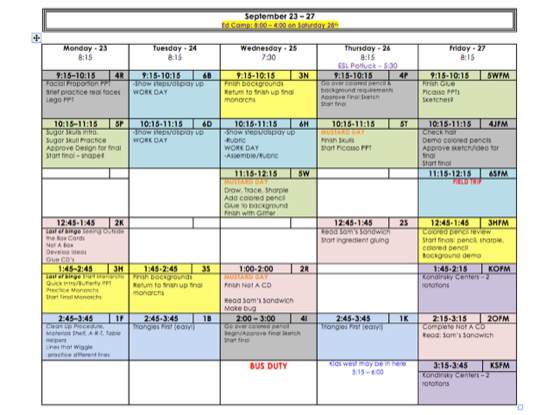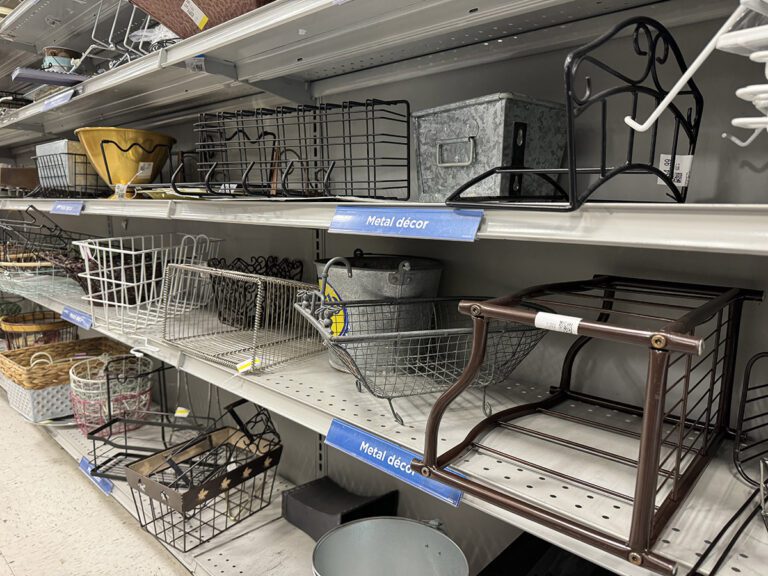As our schedules get more and more full with classes, professional development, clubs, and collaboration, it’s hard not to feel overwhelmed and crunched for time! I’d like to share three easy organizational strategies that you can implement today to save time and help prevent last-minute, frantic prepping. I have cupboards sorted by grade, with shelves sorted by class, but this setup isn’t necessary for the first two tips!
Tip 1: Store work from each class in a folder
I actually make TWO folders for each class, one for current projects and another for completed projects. I generally save projects to take home at the end of the year in individual portfolios for each student, so my ‘completed projects’ folder allows for organized storage. It also allows me to easily select pieces for art shows. I have seen folder sorting done differently in different schools. For example, one of my colleagues provides a folder for each table group in each class, making passing back projects a breeze. However you decide to implement it, class folders definitely keep you organized and save time!
Tip 2: Have a box or tub with essential lesson supplies for each grade
I store these right with my class folders for easy access. The boxes contain items necessary to teaching a grade’s current project. Items might include Davis vocabulary cards, special paper or supplies, books, rubrics, project examples, and anything else that may be relevant to project facilitation. It’s important that each box only contains the teaching tools you need for the specific lesson the grade is currently doing. I generally don’t store the materials being used like paints, colored pencils, pastels, etc. because those are easily accessible to students in my room. I have art room jobs in place (that I will talk about at the AOE Winter Conference), that allow students to take responsibility for getting their own supplies ready. In the rare occasion that one class is way behind or way ahead, I just grab an extra box lid for supplies. To prep for a class, I simply pull out the supply box and that class’s folder and I’m set to go! Note: This is especially helpful when I am traveling to my second school – I just put the supplies necessary from each box in my giant bag, and don’t feel as lost or unprepared!
Tip 3: Keep specific plans
With back-to-back classes, it’s difficult to remember to keep your plans up-to-date, or to remember what step or discussion point you are on with a class. Therefore, I encourage you to sit for a few minutes when you get a break and write down specific notes. Looking at the projects can also help jog your memory. I know everyone is different as far as preferences for keeping plans, but I have found it most efficient to keep my plans digitally in a calendar on Microsoft Word. I can easily enter, delete, copy, paste, and make special notes much quicker than I could doing it all by hand. My cooperating teacher created the basic template in Word by inserting a table and playing around with the settings. I added the color coding for each grade level. I even keep both my school’s plans in one document so I have some sense of continuity.
These strategies have saved me precious time, and really don’t take much effort to set up and implement. Once in place, you may feel a renewed sense of sanity!
I’m excited to share even more time-saving strategies at the AOE Online Winter Conference 2014. Be sure to check it out!
What is your best time-saving trick?
How do you prepare for each class throughout the day? We’d love to hear!
Magazine articles and podcasts are opinions of professional education contributors and do not necessarily represent the position of the Art of Education University (AOEU) or its academic offerings. Contributors use terms in the way they are most often talked about in the scope of their educational experiences.








